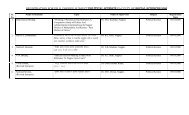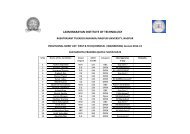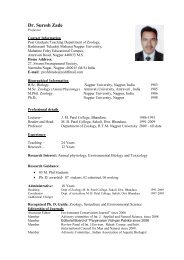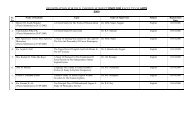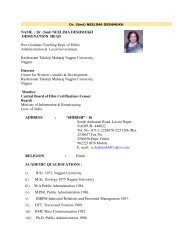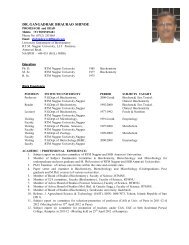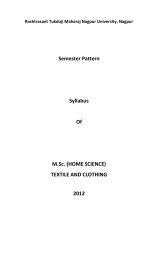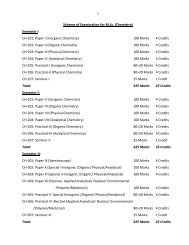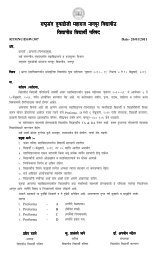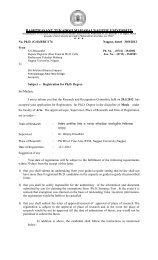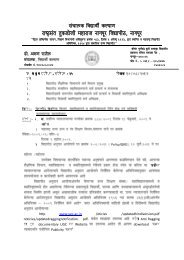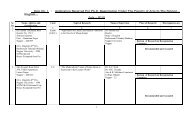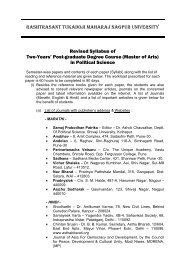Master of Pharmacy - Nagpur University
Master of Pharmacy - Nagpur University
Master of Pharmacy - Nagpur University
You also want an ePaper? Increase the reach of your titles
YUMPU automatically turns print PDFs into web optimized ePapers that Google loves.
5. P.S. Kalsi, 2006, Stereochemistry, Conformation and Mechanism, 6 th edition, New Age<br />
International (P) Limited, Publishers, New Delhi.<br />
6. D. Nasipuri, 2003, Stereochemistry <strong>of</strong> Organic Compounds – Principles and<br />
Applications, 2 nd edition, New Age International (P) Limited, Publishers, New Delhi.<br />
7. Laszlo Kurti & Barbara Czako, Strategic application <strong>of</strong> named reaction in organic<br />
synthesis, Elsevier Academic Press.<br />
8. Peter Sykes, 1985, A Guidebook to Mechanism in Organic Chemistry, 6 th edition,<br />
Longmann Scientific and Technical, Copublished with John Wiley & Sons, Inc, New<br />
York.<br />
9. G.R. Stephenson, 1996, Advanced Asymmetric Synthesis, 1 st edition, Blackie<br />
Academic and Pr<strong>of</strong>essional, London<br />
Subject code: MPC-S10<br />
Subject: ADVANCED PHARMACEUTICAL CHEMISTRY-III<br />
THEORY: 60 Hours (4 hrs. /week)<br />
1. GENESIS OF NEW DRUGS:<br />
i) A brief review <strong>of</strong> the following topics: sources <strong>of</strong> new drugs; leads from natural<br />
products; molecular modifications; random screening; high thought put screening; insilico<br />
screening; structural features and pharmacological activity; prodrugs; s<strong>of</strong>t drugs; isosterism.<br />
selective optimization <strong>of</strong> side activities (SOSA) approach, , new use for old drugs – An<br />
illustrative study with suitable examples<br />
ii) A brief account <strong>of</strong> drug discovery by recombinant DNA technology.<br />
2. PRINCIPLE OF DRUG DESIGN:<br />
Analogue synthesis versus rational design; discovery <strong>of</strong> lead compounds, Pharmacophoric<br />
identification, Prodrugs and s<strong>of</strong>t drug. Physicochemical properties in relation to drug action;<br />
metabolic transformation <strong>of</strong> drugs and its role in development <strong>of</strong> new drug molecules.<br />
QSAR in drug design.<br />
a) Physical properties related to potency.<br />
b) Calculation, measurements and significance <strong>of</strong> various parameter used in QSAR –<br />
(Lipophilicity, steric, Electronic effects). c) applications <strong>of</strong> Hansch Analysis.<br />
Computers in drug design:<br />
Introduction; computer graphics and molecular visualization; computational chemistry<br />
overview, force field methods; geometry optimization; conformational searching; molecular<br />
dynamics simulations; quantum mechanics; structure based drug design and Pharmacophore<br />
perception, predictive ADME.<br />
3. MEDICINAL CHEMISTRY OF<br />
a. Antiviral Agents and agents under development <strong>of</strong> HIV infection.<br />
b. Immunosuppressant and Immunostimulants.<br />
c. Agents used in Neurodegenerative disease Like Alzheimer‟s and Parkinsonism.<br />
d. GABAnergic Agonists.<br />
e. Antidiabetic agents like Peroxisome Proliferator Activated Receptors inhibitors,<br />
Dipeptidyl Peptidase 4 (DPP 4) Inhibitors like Sitagliptin, Vildagliptin, Protein Tyrosine<br />
Phosphatase 1 B (PTP 1 B).<br />
f. Antihypertensives like Direct Renin Inhibitors e.g. Aliskiren<br />
NOTE: “A study <strong>of</strong>” includes an account <strong>of</strong> their origin and development, classification,<br />
structures, mechanism <strong>of</strong> action, SAR, uses and toxicity.<br />
35



